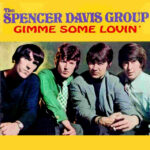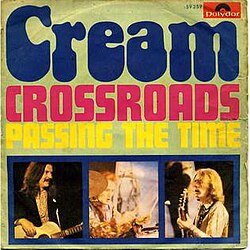 There’s a moment when music transcends genre, nationality, and even time itself—when everything clicks, the beat hits your bones, and you can feel the electricity running through the speakers. That’s exactly what happened when “Gimme Some Lovin’” by The Spencer Davis Group exploded onto the scene in 1966. With its pounding organ, driving bass, and a teenage Steve Winwood howling like a man possessed, the song captured the very essence of what made mid-’60s rock so thrilling: energy, spontaneity, and raw, soulful power. It was three minutes of pure adrenaline—music meant to be felt as much as heard.
There’s a moment when music transcends genre, nationality, and even time itself—when everything clicks, the beat hits your bones, and you can feel the electricity running through the speakers. That’s exactly what happened when “Gimme Some Lovin’” by The Spencer Davis Group exploded onto the scene in 1966. With its pounding organ, driving bass, and a teenage Steve Winwood howling like a man possessed, the song captured the very essence of what made mid-’60s rock so thrilling: energy, spontaneity, and raw, soulful power. It was three minutes of pure adrenaline—music meant to be felt as much as heard.
At a time when British bands were taking American blues and soul and reshaping them into something entirely new, The Spencer Davis Group found a formula that didn’t just imitate—it innovated. “Gimme Some Lovin’” was born out of a spontaneous jam session, written and recorded in a single day, yet it became one of the most enduring tracks of the entire British Invasion era. It’s the kind of song that feels eternal, a perpetual motion machine that still roars to life the second those opening notes hit.
A 17-Year-Old Soul Prodigy
At the center of “Gimme Some Lovin’” was Steve Winwood, barely 17 when he recorded it. His voice, though, carried the grit and fire of someone twice his age. Influenced by Ray Charles and Otis Redding, Winwood had an uncanny ability to bridge the worlds of rock and soul. He didn’t just sing the song—he lived inside it. His wailing delivery, punctuated by Hammond organ stabs, turned what could’ve been a simple R&B tune into a rock ‘n’ roll thunderstorm.
Winwood’s performance was a revelation. Here was a young man from Birmingham, England, channeling the sound of Southern gospel and electric blues with effortless authenticity. When he shouted “Well my temperature’s risin’, got my feet on the floor,” it wasn’t just a line—it was an explosion of youthful urgency. You could feel the sweat, the pulse, the rush of being alive.
It’s easy to forget just how revolutionary that was in 1966. Before long, Winwood’s reputation as a prodigy would lead him to form Traffic and later join Blind Faith, cementing his place among rock’s elite. But “Gimme Some Lovin’” was the spark that lit the fuse—a showcase of a once-in-a-generation talent coming into his own.
The Birth of a Hit
The story behind “Gimme Some Lovin’” is almost as exciting as the song itself. By mid-1966, The Spencer Davis Group—comprised of Spencer Davis on guitar, Steve Winwood on vocals and keyboards, his brother Muff Winwood on bass, and Pete York on drums—were under pressure from their label to deliver another hit. They had already scored with “Keep On Running” and “Somebody Help Me,” but needed something fresh to keep their momentum.
As legend has it, the band was rehearsing at a Birmingham club when Winwood began riffing on an organ line. Spencer Davis added a guitar lick, Muff started laying down a bass groove, and within half an hour, the skeleton of “Gimme Some Lovin’” was born. They recorded it that same day, capturing all the raw immediacy of the jam.
There were no elaborate overdubs, no studio trickery—just four musicians locked in perfect rhythm. Producer Chris Blackwell (who would later found Island Records and work with Bob Marley and U2) had the good sense to leave it unpolished. The result was a song that sounded alive, urgent, and spontaneous. It was released in the UK in October 1966, and by early 1967 it had become an international hit, reaching No. 2 on the UK charts and No. 7 on the Billboard Hot 100 in the U.S.
The Sound of Youth and Fire
What makes “Gimme Some Lovin’” so timeless isn’t just its melody or performance—it’s the sound of youth itself, distilled into music. The song bursts out of the gate with one of the most recognizable intros in rock history: that stabbing Hammond organ, followed by the crisp snare, thumping bass, and handclaps that seem to invite everyone into the groove.
Then comes Winwood’s voice, pure fire: “Well, my temperature’s risin’, got my feet on the floor…” There’s no preamble, no easing into it. From the first second, it’s an all-out sprint. The driving tempo and unrelenting energy create a feeling of forward motion that never lets up. Every instrument works together like a perfectly tuned engine—the bass pumping the rhythm, the drums snapping with precision, and that glorious organ anchoring everything in a wash of gospel-fueled intensity.
What’s remarkable is how simple the song is. There are no solos, no key changes, no structural surprises. But it doesn’t need them. The repetition becomes hypnotic, the rhythm infectious. It’s a perfect example of less-is-more songwriting—the kind of simplicity that only works when every note is played with conviction.
The British Invasion’s Soulful Turn
By 1966, British rock bands were no longer just mimicking American blues—they were reinventing it. The Beatles had moved from pop to psychedelia, The Rolling Stones had fully embraced R&B swagger, and The Who were pioneering the mod sound. But The Spencer Davis Group found their own lane by leaning into blue-eyed soul.
“Gimme Some Lovin’” fit right alongside contemporaries like The Animals and The Yardbirds, but what set it apart was its pure, joyous energy. It didn’t wallow in blues heartbreak—it celebrated it. The song was both gritty and exuberant, the kind of track that made you want to clap along even if you didn’t know why.
It also showcased how British musicians were bridging the Atlantic divide. The band’s love of American soul and gospel came through loud and clear, but their distinctly English sense of urgency and rhythm made it their own. In many ways, “Gimme Some Lovin’” was a blueprint for the future of rock—where groove and grit could coexist with melody and muscle.
The Hammond Organ: The Unsung Hero
It’s impossible to talk about “Gimme Some Lovin’” without praising the Hammond B-3 organ. Its sound defines the track. Winwood’s organ playing was both rhythmic and melodic, driving the song forward while filling it with a churchlike warmth. That sound—thick, pulsing, and soulful—became a hallmark of late-’60s rock and would influence everyone from Deep Purple’s Jon Lord to Booker T. Jones.
Winwood didn’t just play the organ; he attacked it. You can hear the keys click, the tone swell, the volume fluctuate with every hit. It’s alive, breathing, reacting in real time. That authenticity gives the song its heartbeat.
Cultural Impact and Longevity
Over the decades, “Gimme Some Lovin’” has proven itself more than just a 1960s hit—it’s become a rock ‘n’ roll standard. The song’s universal appeal has led to countless covers, including versions by Traffic (Winwood’s later band), The Blues Brothers, and even Great White. It’s appeared in films like Days of Thunder (1990), Notting Hill, The Big Chill, and The Secret Life of Pets, making it familiar to generations who weren’t even born when it was first recorded.
That’s the beauty of “Gimme Some Lovin’.” It’s timeless because it captures a feeling that never fades—the rush of excitement, the thrill of rhythm, the joy of being alive and young and wild. It’s a song that doesn’t ask you to think; it demands that you move.
From the Clubs to the Stadiums
When The Spencer Davis Group first started out, they were a club band, grinding through blues sets for small audiences in Birmingham. “Gimme Some Lovin’” changed everything. Suddenly, they were international stars, performing on television shows and filling theaters across Europe and America.
But fame brought its own challenges. Steve Winwood, still a teenager, soon felt confined by the band’s straightforward sound. Within a year, he left to form Traffic—a more experimental, psychedelic project that reflected his maturing musical ambitions. Spencer Davis carried on with new members, but the original lineup had captured lightning in a bottle, and “Gimme Some Lovin’” remained their defining moment.
The Song’s DNA in Modern Rock
The influence of “Gimme Some Lovin’” stretches far beyond the 1960s. You can hear its DNA in the swagger of early ’70s hard rock, in the organ-driven funk of the ’80s, and even in modern garage revival acts. Bands like The Black Keys, Arctic Monkeys, and The White Stripes all owe something to the energy and simplicity of what The Spencer Davis Group created.
The song also helped elevate the role of the keyboard in rock music. Before Winwood, the organ was often a background instrument, used for atmosphere. After “Gimme Some Lovin’,” it became a weapon—a lead voice capable of carrying a song’s energy as much as a guitar riff could.
The Spirit That Never Dies
Ultimately, “Gimme Some Lovin’” endures because it embodies something universal. It’s not a song about heartbreak, politics, or rebellion—it’s about the primal joy of rhythm, the need to connect, to move, to feel. Every time that organ riff starts, something in the human spirit wakes up.
It’s also a reminder of how spontaneity can create greatness. The song wasn’t overthought or overproduced. It was captured in a moment of pure inspiration, a jam that happened to align perfectly with the energy of its time. That’s part of its magic—you can still feel the room it was recorded in, the spark of four musicians who knew they’d struck gold.
Conclusion: A Fire That Keeps Burning
“Gimme Some Lovin’” by The Spencer Davis Group is more than a 1966 hit—it’s a landmark of rock and soul fusion, a timeless anthem that bridges eras and genres. Its raw power, unforgettable groove, and youthful exuberance continue to ignite audiences nearly sixty years later. The song’s simplicity is its genius; its energy is its legacy.
When Steve Winwood belts that immortal chorus, it still feels like a commandment for every generation that’s ever danced, loved, or needed a shot of pure musical adrenaline: “So glad we made it!” It’s not just a lyric—it’s the sound of joy itself, immortalized forever in three perfect minutes of rock ‘n’ roll glory.


